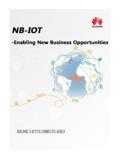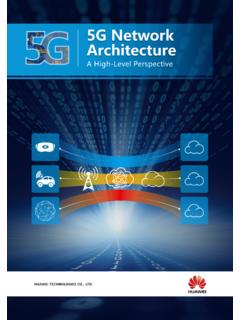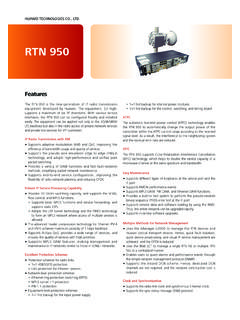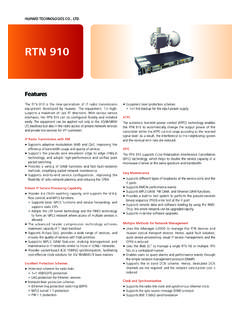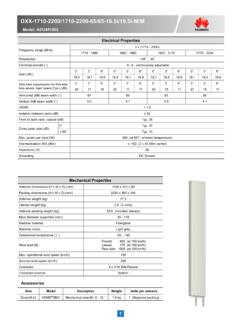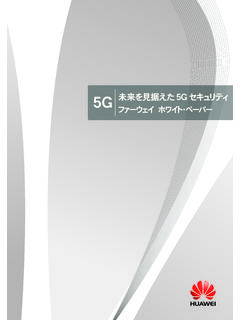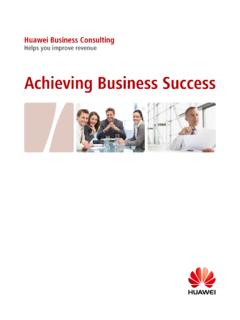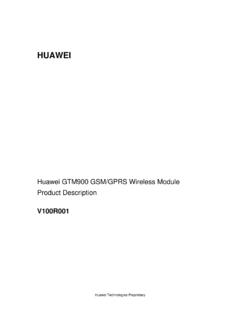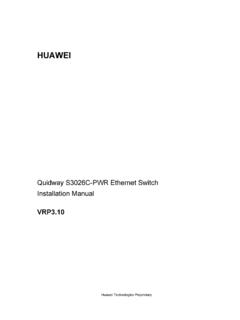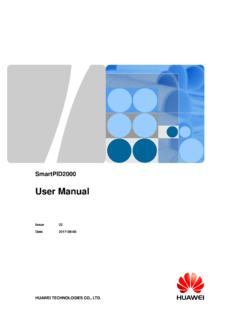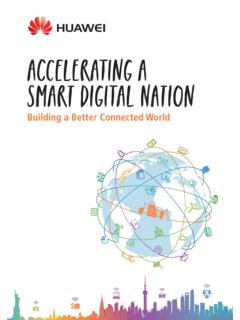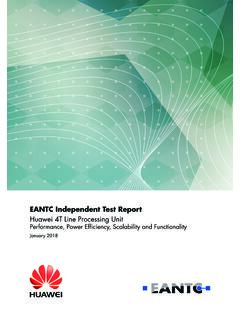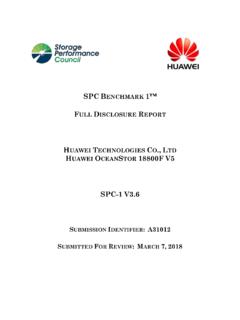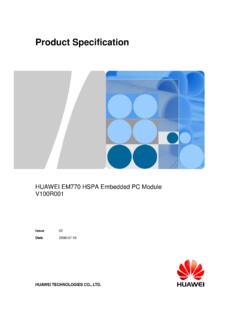Transcription of Leverage Cloud-Native IoT Software Platform To …
1 A Forrester Consulting Thought Leadership Paper Commissioned By HuaweiOctober 2017 Leverage Cloud-Native IoT Software Platform To Accelerate Digital TransformationTable Of ContentsExecutive SummaryIoT Is Key To Digital Transformation Technology Complexity Impedes Enterprise IoT Adoption Building IoT Platforms To Accelerate Digital TransformationKey RecommendationsAppendix124 11 2021 ABOUT FORRESTER CONSULTINGF orrester Consulting provides independent and objective research-based consulting to help leaders succeed in their organizations. Ranging in scope from a short strategy session to custom projects, Forrester s Consulting services connect you directly with research analysts who apply expert insight to your specific business challenges. For more information, visit 2017, Forrester Research, Inc. All rights reserved. Unauthorized reproduction is strictly prohibited. Information is based on best available resources.
2 Opinions reflect judgment at the time and are subject to change. Forrester , Technographics , Forrester Wave, RoleView, TechRadar, and Total Economic Impact are trademarks of Forrester Research, Inc. All other trademarks are the property of their respective companies. For additional information, go to [1-13 PIORS]Project Director: Yini Song, Senior Market Impact ConsultantContributing Research: Forrester s Enterprise Architecture research groupExecutive SummaryRelationships with customers are becoming increasingly digital, and so are companies products and operations and that has sparked companies in every industry to embrace digital business transformation. Companies in the telecommunications (telco) space are looking for internet-of-things (IoT) solutions to bridge the physical and digital worlds, ingesting information and context through sensors from the physical world into the digital and taking actions in the physical world via actuators based on digital , IoT technologies are complex and diversified in maturity and capabilities among different vendors, making it a struggle for technology decision makers to help their business execs take advantage of their transformational potential.
3 Besides, Cloud-Native applications powered by containers provide business and architectural benefits, shaking up cloud platforms from infrastructure to June 2017, huawei commissioned Forrester Consulting to evaluate the adoption trends of IoT across the globe. Forrester conducted an online survey of 203 telecom organizations in China, Japan, Korea, and Europe to explore this topic. We found that an IoT Software Platform with comprehensive capabilities is critical for telco carriers and service providers to accelerate digital FINDINGS IoT is key to digital transformation. IoT is playing a critical role to accelerate digital transformation and achieve strategic outcomes. More than 80% of telco players consider that IoT is important or critical for them to improve customer experience, increase business agility and time-to-market, and get ready for the digital disruption. All interviewed companies have IoT initiatives in different stages from planning to implementation.
4 Technology complexity impedes enterprise IoT adoption. IoT has huge differences from machine-to-machine (M2M), which include integration complexity, infrastructure elasticity, and standard fluidity from a technical perspective, as well as application agility and innovation enablement from a business perspective. Over 60% of telco players realize these differences; however, they must address many critical challenges in the three dimensions of network evolution, business development, and long-term competitiveness. Companies in the telco space must build an IoT Platform to accelerate digital transformation. This Platform spans five layers, including a connectivity layer, security layer, management layer, compute and analytics layer, and application layer. Over half of surveyed companies flag comprehensive capabilities on all five layers as the key priorities of their business | Leverage Cloud-Native IoT Software Platform To Accelerate Digital TransformationIoT Is Key To Digital Transformation Digital businesses win, serve, and retain customers by continuously creating and exploiting digital assets to simultaneously deliver new sources of customer value and increase their operational The transformation toward digital business requires changes of every aspect of your business from digital touchpoints to operational excellence.
5 In the telco space, emerging technologies like IoT are playing a critical role in accelerating digital transformation and achieving strategic outcomes. We found that: No industry is immune to digital disruption. Digital has transformed the market context for every business across different verticals including the telecom industry. The whole value ecosystem of your business, including your customers, your channels, your suppliers, and your technology partners, is becoming digital, and the pace of change is accelerating. It also disrupts you from within, changing the way you design products and services, generate insights, and run business IoT technology is critical for business digitization. Among 203 IoT decision makers in the telco space across the globe, more than 80% of them consider that IoT is important or critical for them to improve customer experience, increase business agility and time-to-market, and get ready for the digital disruption.
6 With IoT they can also gain competitive benefits in many other areas, such as cost savings, operational efficiency, innovation capabilities, revenue generation, employee productivity, and market penetration (see Figure 1). Visionary companies are proactively planning IoT initiatives to drive digital transformation. All of the interviewed enterprises in the telco space have been more or less involved in IoT initiatives. Eighty-three percent of telco carriers are implementing or expanding their IoT solutions or applications, 10% of them are in the pilot stage, and the rest (7%) are planning to implement in the next 12 months. The other two telco forces are also catching up 49% and 61% of virtual network operators and value-added telco service providers respectively are in the pilot or planning stage for their IoT experience, digital readiness, and business agility are the top business priorities where IoT is playing a key Figure 1 How important are your organization s current or planned IoT initiatives to your business priorities?
7 Improve customer experienceCritical requirementImportant requirement52%37%Get ready for the digital disruption37%43%Increase business agility/time-to-market50%30%Reduce costs and/or improve operational ef ciency28%51%Improve our ability to innovate33%41%Increase revenues9%64%Improve employee productivity and effectiveness27%42%Enter new markets/segments12%45%Base: 203 IoT decision makers in China, Japan, Korea, and EuropeSource: A commissioned study conducted by Forrester Consulting on behalf of huawei , July 20173 Technology Complexity Impedes Enterprise IoT Adoption IoT can help telco companies differentiate digital business experiences and achieve digital operational excellence, and telco players have already accumulated substantial experience in M2M initiatives in the past. However, strategy leaders and visionary practitioners in the telco space are still facing critical challenges on their journey of IoT adoption because there are several major differences between M2M and IoT, and the technology complexity of IoT itself further impedes telco companies from IoT TECHNOLOGY IS DIFFERENT FROM YOUR OLD-SCHOOL M2M BY NATURE Major differences between traditional M2M and emerging IoT lie in four areas across both technology and business domains, including integration complexity, infrastructure elasticity, and standard fluidity from a technical perspective, as well as application agility and innovation enablement from a business perspective (see Figure 2 and Figure 3).
8 Figure 2 Regarding the technology differences between M2M and IoT that possibly challenge IoT deployment, to what degree do you agree with the following statements? Base: 203 IoT decision makers in China, Japan, Korea, and EuropeSource: A commissioned study conducted by Forrester Consulting on behalf of huawei , July 2017M2M focuses on terminal device and communication/connection between devices; IoT focuses on more complex integration among terminal, network edge device, cloud Platform , and internal apps in enterprise DC Strongly agreeAgreeM2M use case is simpler compared to IoT; IoT Platform needs to serve different business scenariosCompared to IoT Platform , M2M has less data and is less dynamic in real time; while IoT aggregates various businesses together and needs to handle elastic workloads of massive IoT data in real time31%45%31%42%36%35%26%44%23%39%22%48% Technology architecture for M2M is not as advanced as IoT Platform where it can Leverage enterprise cloud (including IaaS/PaaS/ container/etc.)
9 To meet the elasticity required in data processing M2M is customized by appointed developer to appointed machines; IoT Platform needs to consider standardized protocols and interoperability M2M protocols are designed for speci ed business scenarios; IoT Platform needs to realize cross-industry and function protocol support Integration complexityLegacy infrabottlenecksFluidstandardsandprotoco l4 | Leverage Cloud-Native IoT Software Platform To Accelerate Digital Transformation The integration complexity across edge devices and enterprise networks challenges IoT deployment. First, M2M normally focuses on terminal devices as well as communication and connection between devices, while the focus of IoT is on a more complex integration amongst terminal devices, network edge devices, cloud platforms, and enterprise internal applications. Second, M2M use cases are simpler compared with IoT platforms, which need to serve different business scenarios.
10 Therefore, as depicted in Figure 2, 73% of telco companies agree that the integration covers diversified scenarios, which is the highest among all differences between M2M and IoT. Legacy technology infrastructure cannot handle elastic workloads of massive IoT data. Seventy-one percent of IoT decision makers agree that M2M has less data to transmit and process as compared with IoT scenarios; the data traffic over IoT networks is not only massive and much more dynamic, but it also needs to be processed in real time or near real time for instant decision making. And the traditional technology architecture for M2M is not as advanced as an IoT Platform , as the latter one can Leverage enterprise cloud platforms, which might include infrastructure-as-a-service (IaaS), Platform -as-a-service (PaaS), or even container-based Cloud-Native capabilities, to meet the elasticity requirements in data processing for modern applications.
